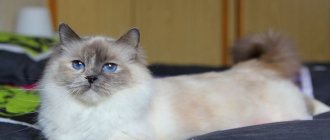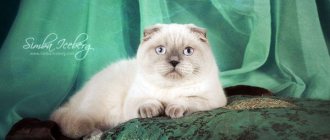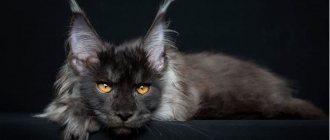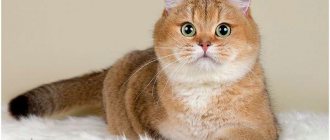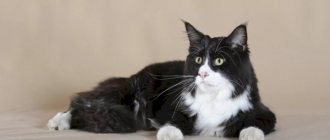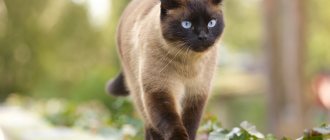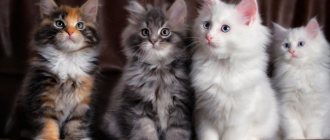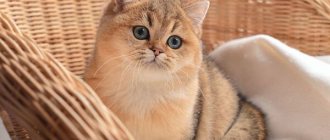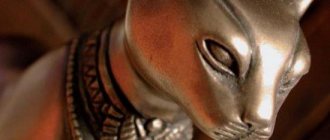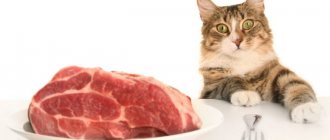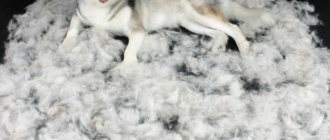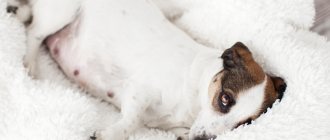Almost all lovers of such pets know the color of color point cats, thanks to the Siamese and Thai breeds. That is why it is quite often confused. But these are not all types of cats that have such an attractive color of their fur. In some distant countries this color may also be called Himalayan. Cats of these breeds are often affectionate and cannot be alone.
Color Description
If translated from English, “color” means color, and “point” means a point. Points are small dark spots located on the face, tail, paws and ears.
The usual color of a cat is solid. The pigment is evenly distributed throughout the animal’s fur and body. Therefore, you can see the uniform color of the pet.
For a color point cat, everything is completely different. Their DNA contains the cs gene, thanks to which the pigment enters only the peripheral parts of the body, that is, the cold ones. They are located at a relative distance from the warm ones. Such areas are the ears, tail, paws and muzzle.
In other parts of the body, where the temperature is relatively higher, the pigment is not able to manifest itself actively. Scientifically this is called acromelanism .
As a result, the pet’s body is painted a lighter color than the rest of the body. The overall color tone remains uniform, but only changes in its saturation and intensity. The more pronounced the border between light and dark coats is, the higher the value of such a cat for exhibition work.
Dark pigmentation can be more than just brown. There are also these colors:
- Black.
- Lilac.
- Smoky.
- Reddish.
- Blue.
Based on this, individual varieties are distinguished, for example, seal point, red point, blue point, etc. Certain breeds can combine several shades at once.
Variations
Colors are divided into three groups: solid, tortoiseshell and tabby. In the first case, the marks have a uniform shade without foreign inclusions. Tortoiseshell implies the presence of heterogeneous spots (a combination of red, brown, blue, cream colors), this type is found only in female animals.
Blue tabby point
Tabby cats have distinct stripes on their fur. There must be a pattern on the forehead resembling the letter M.
Continuous ones include:
- blue – the body has a slightly bluish tint, the markings are gray or blue;
- seal – dark brown markings, cream body fur;
- chocolate or choklit - spots of rich milk chocolate color, body color - white or slightly creamy;
- cream – soft cream, body slightly lighter than the spots;
- red – the spots have a red (rich red) color, the body is cream or light apricot;
- lilac – the fur on the body is white, the markings are purple;
- cinnamon – cinnamon-colored spots, beige body;
- faun - the fur on the body is beige (almost white), the spots are light purple.
Tonkinese fawn point kitten
Tortoiseshells include (the first word in the name is the main color of the spots, the second word is the color of the inclusions):
- blue cream;
- seal-cake;
- Lilac cake;
- Chokli-torty.
Tortoiseshell British cat
There are various variations among tabbies. The word tabby must be added to the name.
Features of color
The color point cat breed is no longer some kind of exotic. Every year such pets are becoming increasingly popular. But they still have certain features:
- Color point kittens are always born only in light shades. Only after a few days do the first pigment spots begin to appear on the paws, tail, and then on the face. This is due to the fact that during intrauterine development the kittens were exposed to constant warm temperatures. After birth and exposure to a colder environment, the coloring pigment begins to activate, which entails darkening of certain areas of the body.
- The appearance of a point kitten can only be guaranteed if both of its parents also have a pigmented color. But sometimes there are exceptions. One or even both parents can have a solid coat, but be carriers of the cs gene, which is responsible for darkening the peripheral areas of the body. In this case, some kittens will turn out to be pointing.
- The intensity of the color difference depends on the temperature in which the animal is located. The lower it is, the darker and richer the pigment areas will be.
- The cs gene is directly related to the color of the pet's eyes, which must be blue. In this case, the breed does not matter. The brighter and more saturated the color, the better the color of the animal appears.
It must be remembered that cats kept in cool conditions may completely lose their unique color. The ideal temperature for such breeds is from +25 degrees Celsius.
Striped colors.
A separate group of Mekong cats are stripes - tabby or lynx (tabby point, lynx point). Cats of this color have markings that are not solid, but with clearly visible stripes of any color. The name must include a color designation. For example, seal tabby point (with black stripes), blue tabby point (with gray-blue stripes), chocolate tabby point (with milk chocolate stripes), etc. The tabby point color is also called lynx point. A tabby-point cat should have a clear “M” pattern on its forehead, a pattern around the eyes, and a spotted area around the whiskers. On the front legs, torn rings from the toes go upward. Stripes on thighs; the back of the hind legs to the hock is solid color. The ears are solid color, but with the obligatory “thumb mark” (a spot of lighter tone on the outside of the ear), which is less noticeable in diluted, weakened colors. The inner part of the ear is lighter. Tail with unfinished rings. The nose is pink or brown with a border of the main color. Paw pads of the same tone with markings.
Seal-Tabby Point MBT n 21 or n 33 21 – dark brown striped markings, genetically – black, indicated by the letter “n”, number 33 – solid, without stripes (this number indicates that it is “ Siamese” color), 21 - stripes, i.e. color code n 33 21, possible n 21. Body color from almost white to cream (fawn), darkening with age to light brown-gray with stripes along the body. Mask, ears, paws, tail with brown-gray stripes, which become brighter with age. All colored parts (mask, ears, paws and tail) should be as close in color as possible. The mask should not be connected to the ears, much less go to the back of the head. The nose is pale orange-pink with a black edging, the paw pads are dark brown. Disadvantages: Pale eye color. The mask markings are not clear enough. The rings on the tail are not clear enough. Heterogeneous color of markings.
Blue-tabby-point color (Blue-tabby-point) MBT a 21 or a 33 21 (there are only a few Mekong bobtails in this color) - gray striped markings, genetically - weakened black, indicated by the letter “a”, number 33 - solid, without stripes (this number shows that this is a “Siamese” color), 21 - stripes, i.e. color code a 33 21, possible a 21. Body color from almost white to cream (fawn), darkening with age to light gray with stripes along the body. Mask, ears, paws, tail with gray stripes, which become brighter with age. All colored parts (mask, ears, paws and tail) should be as close in color as possible. The mask should not be connected to the ears, much less go to the back of the head. The nose is pale orange-pink with a black (dark gray) edging, the paw pads are light pinkish-brown. The main color faults are dark spots on the belly, white spots on the points, and unsaturated eye color.
The Red-tabby-point color MBT d 33 21 is a fairly rare color for Mekong Bobtails (especially among cats). The snow-white body (sometimes with a slight golden tint) is combined with red striped points. The eyes against the background of the red “mask” look especially rich cornflower blue. The color of Red Tabby Points differs, like all tabby colors, in certain features. Namely: the presence of red stripes in the form of rings on the front legs, the presence of red stripes on the tail, a pattern in the form of the letter “M” on the forehead. These stripes look very elegant and fun, especially on curled ring ponytails. The ears and points on the hind legs are solid color. The nose and paw pads are always pink. Cats of this color with red ears and muzzles resemble foxes. And the snow-white sparkling fur gives special elegance and grace to these cats. Throughout the life of an animal of such a wonderful color, the body remains snow-white. Only in old age does the body acquire a slightly golden hue. The appearance of Red Tabby Point Mekong Bobtail cats (as well as the Blue Point Mekong Bobtail color) is unlikely to resemble the traditional “Siamese” color.
Mekong bobtails of lynx-point colors are unique and very few in number; working with this color is a pleasure, although there are quite a few difficulties in working with this color.
Main breeds
Thai and Siamese cat breeds are precisely those that have the color point pigment initially. This is implied by the standard. But there are other types. In addition to plain coats, they also have point subspecies. These include:
- Persian. This is the first breed that has been successfully turned into a pointing breed, with the exception of the Siamese. The Point Persian was created by mating a Siamese cat with an ordinary Persian cat. But there is also a small minus for the owners - a lot of attention must be paid to the luxurious fur of these pets.
- British colorpoint cats. This is a separate subspecies of ordinary Britons, which was first bred not so long ago. Breeding them is quite a difficult task, so babies of this breed are highly valued.
- Scottish straight. Representatives of this breed have darkened areas that look like a light haze. It was possible to breed by mating the best specimens of the British and Persians. These are very beautiful cats, and they also have a soft and flexible character.
- Neva Masquerade. These are Siberian cats with pigment coloring. They were first bred by St. Petersburg breeders by crossing Siberians and Siamese. The artificially bred breed is extremely beautiful. Its representatives have a rather large body with a very thick coat, which was inherited from their Siberian ancestors. It goes well with the colors of the Siamese, as well as the deep blue eyes.
- This coloring is found in all breeds of sphinxes, for example, Canadian or Peterbalds. They have point coloring on their skin, since the fur is completely or almost completely absent.
This is not the entire list of breeds with this coat color. There are also very rare ones, for example, snowshoe or Burmese. But they are not yet very common in the world.
Scottish Highland Straight
The Scottish Highland Straight is a subspecies of the Scottish cat. It is distinguished by the fact that it has long hair and erect ears. This variety has an unusual color. They brought her out in the 70s. years of the last century, when the British crossed with the Persians. Kittens from these breeds were able to get only the best. They have a very calm and friendly character, as well as a cute appearance. Highland Straights are easy to maintain. There is also a tortoiseshell variety, which also has a point color. Description of the breed:
- Quite long coat that is very easy to comb. Has a relatively dense undercoat.
- The ears are small in size with rounded tips and stand erect.
- The eyes are large and round in shape. Color may vary. He is completely dependent on wool.
- The body is strong, muscular, of medium size. Often these cats have a round shape.
- The toes are quite tightly clenched. The limbs themselves are long.
- The head is round and has a convex skull.
- Average tail length. He is very fluffy and active.
- These cats live from 10 to 20 years.
- The average weight of animals is 3.5 kg, and that of a cat is 5 kg.
- Standard length is 30 cm.
This breed is very flexible. But their main advantage is their tenderness and friendliness. When buying a kitten, you should pay attention to the color, as there should not be white color.
If it is present, then such a pet will not be able to participate in exhibitions.
British Shorthair
There is a well-established opinion that this breed was brought to Great Britain in the first century BC by the Romans. The main advantage at that time was considered to be short and very thick wool. It helped protect cats from excessive moisture, as well as small parasites while hunting rodents. The British breed was very hardy and had good health. They were used as hunters. Only many centuries later they began to be looked at from the point of view of beauty. The first exhibition took place in 1871. Description of the breed:
- The British Shorthair cat has a thick and dense coat. The color may be completely different.
- The eyes are large and round in shape. Very often a red tint appears.
- The ears are small and straight, set low.
- The body is of medium size. Cats are usually strong and slender.
- The legs are straight and short.
- Massive round head.
- The neck is powerful and thick.
- The tail is fleshy. Has a rounded end.
- The standard weight for a female is 4 kg, for a male - 6 kg.
- These cats usually live 10-15 years.
The British breed can only be long-haired or short-haired.
A long coat is standard for this species. The short one appeared thanks to the mating of a Briton and a Persian. Many experts argue that the differences are only noticeable in the length of the coat. Although sometimes changes in the chin may also appear.
Compared to the Scots, the British are distinguished by their independence. They may very often do things contrary to instructions. This breed easily tolerates loneliness, but still has a kind and affectionate disposition. Quite often, the British are wary of strangers and do not allow them to touch them.
Bicolors
Bicolor cats have a coat that combines white with other tones. In purebred animals, the pattern on the body is located symmetrically. Common bicolor varieties include spotted and striped.
Calico
The calico pattern is a combination of white with tortoiseshell or tabby. Among cat lovers, individuals whose fur resembles a Harlequin costume are highly valued - a predominance of white on the body in addition to black (the top of the head and ears).
Wang
The name van was given to individuals whose tail is a different color than the body. Sometimes there are colored markings on the head.
Character of color point
The character of the color point is always very cheerful . These cats are quite energetic and have taken all the best habits from their Siamese ancestors. In some cases, they are jealous of their owners, and may also be offended that they are given too little attention. But still, cats are not at all aggressive and make excellent contact not only with people, but also with other animals that are in the apartment.
They are also distinguished by a certain obstinacy. It is better not to offend such a breed, because cats will remember everything in the future. But when a pet is surrounded by love and care, it will be a very loyal friend.
This breed will appeal to those who rarely leave their cozy apartment for a long time. Colorpoint cats need constant attention from their owner. They want to be involved in a person's life. Pets will be happy to crawl under the blanket or jump on your lap and wait to be petted. The cat will immediately begin to purr contentedly.
Tabby colors
If your cat has spots, stripes or other clearly defined patterns, then his color is most likely one of the “tabby” color groups. The base color of the coat and the color of the tabby markings depend on the color variation, which also determines the color of the nose and paw pads. Silver tabbies have a pale base color and white hair roots. Markings should be contrasting and clearly defined. Breeding a cat with the right pattern is not easy. There are five main varieties of tabby color:
1. Mackerel (mackerel tabby) The pattern is represented by parallel vertical stripes, there should be no spirals on the side and many spots.
2. Marble colors (marble) (tabby blotched, classic tabby) The classic pattern is characterized by “butterfly” spots on the shoulders, from which three stripes extend along the ridge. On the sides there is a spiral in the shape of an oyster, and the chest is crossed by two narrow stripes in the form of necklaces. On the forehead, dark stripes form the letter M, on the tail and limbs there are even stripes in the form of rings, and the belly is spotted.
3. Spotted tabby Spots are located throughout the body, can be large or small, sometimes in the form of intermittent stripes.
4. Ticked tabby, also known as “agouti” or “Abyssinian” Agouti color means that each individual hair is ticked - two or three transverse stripes of different colors. The color of the coat is uniform, without stripes or spots on the body, on the back it is somewhat darker than the rest of the coat. The eyes and nose are outlined with a “rim”. This “wild” color is typical for Abyssinian cats, but is also found in other cats.
5. Patched tabby Patched tabby has patches of two different colors interspersed with each other: brown patched tabby - reminiscent of fall foliage, with patches of brown and red tabby. This color is also known as torbie; blue patched tabby – soft color with patches of blue and cream tabby.
Possible options:
cream tabby (coat color is cream, markings are dark cream);
· black (black tabby) (the main color is warm, golden brown, penetrated by distinct black stripes);
· red (red tabby) (the main color is red, accompanied by a contrasting pattern of deep red color);
· chocolate (chocolate tabby) (basic coat color down to the roots of the hair is ivory with a chocolate zonal pattern, accompanied by a contrasting dark chocolate pattern);
· lilac (lilac tabby) (basic coat color down to the roots of the hair is ivory with a lilac zonal pattern, accompanied by a contrasting dark lilac pattern).
· blue cream silver tabby (coat color is light blue, evenly mixed with soft cream, evenly distributed throughout the body, the undercoat is silver-white);
· silver-black or silver tabby (main color silver, with a contrasting black pattern, green or hazelnut eye color);
· blue silver tabby (coat color is pure speckled silver, accompanied by a contrasting black pattern);
· silver-chocolate or brown tabby (coat color is pure speckled silver, accompanied by a contrasting milk-chocolate pattern);
· silver-red, also known as cameo (red silver, cameo) (the color of the coat is pure speckled silver, accompanied by a contrasting red pattern);
Maintenance and care
Almost all breeds with this color are more valuable when the contrast between the base color and the pigment parts is strong. Therefore, the main task of a person is to maintain the correct color. In addition to temperature, other factors also affect color.
The first one is age. Almost every cat darkens over time . The pet’s diet can also greatly affect the color. An indisputable fact is that carrots and seaweed, which contain a lot of iodine, can change the color of an animal. You should be careful about the composition of the feed. It is not advisable to give your cat vitamins that contain seaweed and kelp. You should not feed foods containing a lot of copper.
Experts have noticed that Thais begin to quickly turn dark when eating beef, any seafood, liver and buckwheat. If there is a predisposition, then the best solution would be to use special feed.
Any damage can also change the color of fur and even skin. In areas where injury or surgery has been performed, the fur will be much darker. This is due to the fact that that area of the body will become much colder. In some cases, color may return after the first molt, but this does not always happen.
If you definitely need to have surgery, then it is advisable to choose a place that will be least noticeable. After the procedure, it is necessary to carefully wrap the incision until complete healing.
We must not forget about trimming the claws. This should be done so that the pet cannot hurt itself.
Tortoise shell (tortoiseshell, tortie)
Many randomly mixed large spots of two different colors, well delimited from each other and distributed throughout the body. There should be no spots too large or too small in the color. The nose (as well as the paw pads) should match the color - one color or another, perhaps spotted. The eyes are copper or dark orange. Possible options:
· classic tortoiseshell (tortie): the coat color is red with black spots, and the red can be of various shades. “Flames” on the sides and back are desirable, the colors should be warm and radiant;
· blue tortie, also known as blue cream (blue tortie, blue cream): The color of the coat is light blue, evenly mixed with soft cream, evenly distributed throughout the body. Small cream spots are allowed if they fit into the overall picture. The nose is grey-blue, pink or grey-blue with pink spots. The paw pads are the same. Eye color is even copper or dark orange. Excessive large spotting, dark blue or red tones in color, and a striped pattern are considered a fault.
· chocolate tortoise: milk chocolate and cream clearly demarcated spots evenly distributed throughout the body. At the same time, the cream color comes in all sorts of shades. The colors should be warm, and a tan mark on the face is desirable. The nose is milky chocolate colored, pink or milky chocolate colored with pink spots. Paw pads range from cinnamon to chocolate, pink or chocolate with pink spots.
· lilac tortie: lilac or light gray with a slight pink sheen and light cream spots evenly distributed over the entire body. A tan mark on the face is desirable. The nose is lavender, pink or lavender pink with light pink spots. The paw pads are lavender, pink or lavender pink with light pink spots.
Owner reviews
I could never imagine my life without some animals. I always considered everyone I had as part of the family. The cat was bought about 5 years ago. He was about a month old then. He didn’t even know how to feed himself or go to the toilet yet. Most likely, the seller needed to sell the cat as quickly as possible, so he lied a little about the baby’s readiness for independent life. In general, the kitten was named Bonya.
Color point cats are very cute and gentle kittens, and adult cats too. They are quite interesting to watch. They are funny, active and cheerful.
Zhenya
We bought a British Shorthair as an adult. At that time she was 10 months old. She is very clingy by nature and loves a lot of human attention. She herself jumps into her arms, but only in those cases when she exactly wants it. You can squeeze for hours, the cat is very patient.
Lilya
We have a Sphynx Peterbald cat. They set up a special place for her to sleep, but she only sleeps there during the day. At night he always comes to my bed.
The character is quite capricious.
She hates being alone. When this happens, he immediately starts screaming. You can't just pick it up and play. You'll have to wait until she wants to. If she doesn't like something, she may even throw herself. She was scratched and bitten several times. Catherine
What does genetics have to do with it?
Many people are probably wondering: how did it happen that all the representatives of this group are colored so uniquely? To answer this question, you will have to go back many decades and remember that cats became the object of attention of specialists in the second half of the 19th century. The British then began to perceive them as purebred animals and specially breed certain species.
The color point color is found in cats such as Ragamuffin, Highland Fold, Balinese, Siberian and American Shorthair.
The Siamese and Persian cats marked the beginning of the official registration of cat breeds. Later they became the progenitors of many modern cat breeds, including color points. Siamese cats came to Europe in 1870 and became favorites of many families. Blue eyes and unusual coloring are what attracted me in the first place.
Some scientific facts.
The color of the coat and eyes depends on a polymer pigment called melanin. It is formed from the amino acid tyrosine under the influence of the enzyme tyrosinase. It is this enzyme that is controlled by the gene that determines color, which is called Color. This gene is designated by the letter “C”. When the C gene is mutated, no active tyrosinase is produced and the pigment does not appear. In this case, the cat is born an albino, that is, uncolored. And the mutated gene is already indicated by the small letter “c”.
Where did these black spots come from then?
Scientists have discovered the Himalayan gene cs, or ch, which is also formed from a mutated gene C. But in this case, the enzyme tyrosinase becomes heat-sensitive, that is, depending on the temperature, it changes its activity: at high temperatures, tyrosinase is inactive, and as soon as the temperature drops, melanin in the cells, fur begins to be produced and dyes the cooled areas in darker colors. This is how the Siamese color turns out, which, by the way, is found not only in cats. In the last 30–40 years, geneticists have developed a large number of breeds that differ in color point color.
Proper care for your pet
Regular care, quality nutrition, attention and love will ensure your pet has a normal weight and a long life.
- Water procedures. Scottish Straight cats do not like water very much, so they need to be bathed when they get dirty and before the exhibition. It is worth using baby or special cat shampoo and making sure that water does not get into the ears. Afterwards, dry the cat and place it near the heater, avoiding drafts. The fur should be combed once a week.
- Ear care. Inspect them regularly and clean them from dirt using a cotton swab soaked in vegetable oil.
- Eye care. If your Scottish cat has discharge from the eyes that shouldn't happen, contact your veterinarian for advice.
- Claw care. The transparent part of the claws should be trimmed with tongs or scissors. At the same time, the cat must have a scratching post.
- Help during heat. After 7 months, a Scottish cat may go into heat and become irritable. During this period, it is necessary to add sedative herbal remedies to the cat's food to alleviate the condition of the expectant mother.
In turn, you need to submit your pet for preventive examinations in order to identify any diseases in the early stages, as well as get vaccinations on time that will protect the mustachioed from the possibility of contracting an infection. It is also always a good idea to consult with a cat care professional to find out your cat's exact weight.
Origin story
In the early 30s of the last century, the famous American breeder from Boston decided to breed a variety of Persian cat with a Siamese color.
The work continued for quite a long time and only in 1936 the first kitten appeared that met all the requirements of the experiment. Over the next few years, the breed was improved in order to consolidate the Siamese color and Persian face.
In 1955, it was officially recognized by the felinological organization GCCF. Later, in the mid-seventies, these cats were classified as part of the Persian group.
Appearance
Today, color point cats differ significantly from those that were obtained as a result of the first experiments. The structure of their coat and body structure are very similar to Persians.
The body is squat, muscular, with a broad, massive chest and well-developed shoulders. The limbs are squat and stable. The tail is of medium length and unusually fluffy.
On a round, proportional head, under long hair, small ears with rounded tips are almost invisible. They are located quite low and widely spaced. The round cheeks and developed chin are clearly visible on the muzzle.
Large, round, very expressive eyes are set widely apart and most often have a bright blue color.
Luxurious wool is another distinctive feature of this breed. Its length can reach up to 12 cm. The wool is very thick, thin, and has a silky structure. It forms a chic collar on the neck and chest.
The color of the breed is determined by the color of the spots. The most popular is with brown, almost black, markings. At the same time, the general background is light, almost white. There are cats with blue and lilac markings.
We suggest you read: Cat bite - What to do if bitten by a cat, first aid and treatment methods
Depending on their color, all representatives of the breed are divided according to color into groups called:
- Blue Point
- Chocolate point
- Lilac Point
Nutrition
The feeding place must be permanent. When organizing meals, you should choose a natural diet or ready-made food and stick to one type, without mixing them. Food of any kind should be warm.
A natural diet includes boiled beef and chicken, boiled egg yolks, and low-fat fermented milk products. You should limit your consumption of seafood and liver when eating natural foods. Additionally include vegetables and fruits. Thais often eat them raw. If the pet does not want to eat the vegetables whole, then they are grated on a fine grater and mixed with the meat.
A vitamin complex is periodically added to food. An adult animal needs two meals a day. Babies are fed 5-6 times a day in small portions to replenish energy reserves. Clean water should always be available, especially when using dry food.
Watch the water
Buying a purebred Scottish Straight kitten
A kitten at the age of 3-4 months is already psychologically stable, can eat adult food and use a litter tray, and most importantly, it has already been vaccinated and is ready to tear itself away from its mother. Therefore, it is worth purchasing a small Scottish dog at this age.
A good place to buy is at a show or a reputable nursery. If you like a little mustache, then take a closer look at his behavior - he should be cheerful, playful and well-groomed.
As soon as the baby grows up, his character and excessive hyperactivity will be replaced by balance.
Once in a new home, the little furry will quickly adapt, and most importantly, give its residents joyful emotions and a devoted friend in his person.
What to name a Scottish kitten
Many new owners of plush kittens prefer to follow the beaten path and give their pets well-known nicknames: Barsik, Murzik, Vaska. But for open-minded cat lovers, choosing a name for a boy or girl is a great way to show creativity and imagination.
What nickname can you come up with for your pet so that it is associated with Scotland? This is not difficult, because the history and culture of this country are known throughout the world. Kilt, bagpipes, whiskey, tartan - this is not a complete list of words that make us think of distant Scotland.
You can rack your brain and come up with a name based on the suggested words. But most often male kittens are named Scott (Scotty), Shot (Shotti), Valli, Rob, Roy, Baxter, Archie and even Holmes or Watson. The girls are called Foxy, Orange, Athena, Shakira, Martha, Chessie, Shaddy.
Chinchilla
A kitten or adult Scottish Straight cat with such a spectacular color looks amazing. Breeders do not skimp on laudatory epithets for cats with similar coat colors, comparing them to silver or black pearls. Indeed, wool of such a rare and complex color looks like an exquisite jewel.
Visually, the coat looks like a single color, but if you look closely, you can see a thin “spraying” on the coat. This effect is achieved by painting the ends of the hairs to 1/8 of the length. There are at least ten variations of chinchilla color: lilac, chocolate, as well as cream and red (cameo). The eyes should be green. By nature, chinchillas are calm and friendly.
